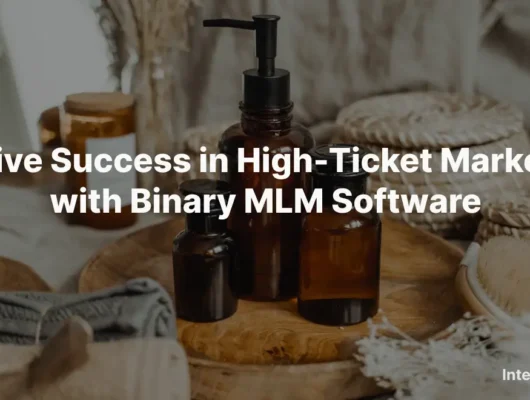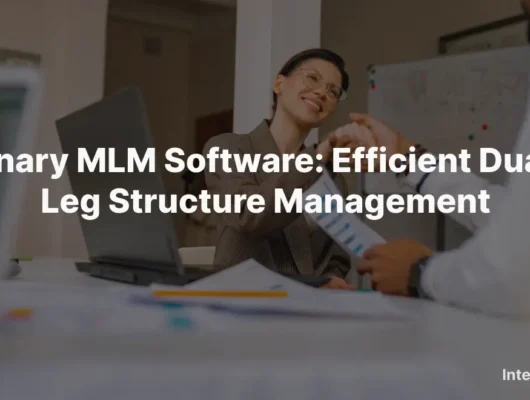Though the recent rise in popularity and rapid growth of the direct selling industry is exciting, it also brings significant challenges.
With more interest in direct selling and its products, companies must manage an increasing number of customers and distributors without sacrificing quality. To effectively handle this growth, MLM software designed for 1 million users is essential.
Perfection is not attainable, but if we chase perfection, we can catch excellence. — Vince Lombardi
The transition from handling a network of thousands of users to millions of them is undoubtedly rife with challenges. Along with the complexities involved, the demands of the user base grows exponentially.
If your software solution is incapable of handling such volumes, it may disrupt your workflow with data bottlenecks, system crashes and slower processing times.
So, as your MLM business grows, it is important to switch to a high capacity MLM Software that can keep the pace with your growth. A high capacity MLM software is not just about empowering your business but it is about managing an expanding network and unlocking your potential to greater successes.
Let’s take a look at how an MLM software handling 1 million users is capable of transforming your business.
Table of Contents
The Challenge: Handling 1 million Users
Handling a user base of 1 million presents significant challenges for any MLM software.
Here are some of the complexities and potential bottlenecks involved:
Complexities and Potential Bottlenecks
As the user base grows, a large user base MLM software must efficiently manage a vast network of relationships, transactions, and data. This complexity can lead to several challenges, including slow response times, system crashes, data inconsistencies, and an inability to handle high volumes of concurrent transactions.
- User Management: Managing a large user base involves tracking user profiles, hierarchical relationships, and activities. A high capacity MLM Software must handle complex queries and updates related to user structure, commissions, and downlines efficiently.
- Transactional Load: MLM systems often involve high volumes of transactions, including purchases, commissions, and payouts. An MLM software handling 1 million users need to process and record these transactions in real-time without causing delays or data inconsistencies.
- Data Integrity: Ensuring the MLM software efficiency, accuracy and consistency of data across the system is critical. With 1 million users, data integrity issues can arise from concurrent updates, race conditions, and synchronization problems.
- Scalability of Database: The database of a large user base MLM software must be capable of handling large datasets and high transaction rates. Scalable MLM Solutions include efficiently querying, updating, and indexing large volumes of data while maintaining performance.
- System Performance: As the number of users grows, so does the demand for system resources. Ensuring fast response times and minimizing latency under heavy load is essential for a positive user experience in scalable MLM Solutions.
- Security and Compliance: With a large user base, security becomes more complex. Protecting sensitive user data, preventing fraud, and ensuring compliance with regulations (e.g., GDPR, CCPA) are critical.
- Network and Infrastructure Load: The underlying infrastructure of large user base MLM software must handle peak traffic loads, including high numbers of concurrent requests, data transfer, and API calls, without becoming a bottleneck.
Common Pain Points of Traditional MLM Software:
Traditional MLM software solutions often struggle with scalability and performance under heavy loads. Common issues include limited server capacity, poor database management, lack of efficient load balancing, and inadequate handling of concurrent transactions. These limitations can cause significant downtime, leading to a poor user experience and potential loss of business.
- Monolithic Architecture: Many traditional MLM systems use a monolithic architecture where all functionalities are tightly coupled. This makes it challenging to scale individual components independently and can lead to performance bottlenecks.
- Limited Scalability: Traditional systems may struggle to scale horizontally, leading to issues when handling high traffic or large user volumes. They often rely on vertical scaling (adding more resources to a single server), which has its limits and can become costly.
- Database Performance Issues: Legacy MLM solutions may use single-instance databases without adequate indexing, replication, or sharding. This can lead to slow query performance, long transaction times, and difficulties in managing large datasets.
- Lack of Flexibility: Traditional software may lack flexibility in adapting to new requirements or business models. Customizations can be difficult and costly, making it challenging to implement changes or new features quickly.
- High Operational Overhead: Maintaining and managing traditional MLM software can be resource-intensive. Tasks such as patching, upgrading, and monitoring may require significant manual intervention and can lead to increased operational costs.
- Inadequate Security Measures: Older systems may not have up-to-date security practices, leaving them vulnerable to attacks. They may lack modern encryption, authentication, and authorization features necessary for protecting user data.
- Poor User Experience: Legacy systems might not provide a seamless user experience, especially on mobile devices. They may lack responsive design, leading to usability issues on different screen sizes and devices.
- Limited Integration Capabilities: Traditional MLM software might have limited support for integrating with other systems or third-party services, hindering the ability to extend functionality or leverage modern tools and services.
Our Solution: Scalable MLM Software
To address these challenges, we designed our MLM software with scalability and performance as top priorities. Here’s how our solution stands out:
Overview of Software Architecture and Infrastructure Design:
Our High Capacity MLM Software is built using a microservices architecture, which allows us to break down the application into smaller, independent services. This modularity enables better management of resources and easier scaling. We utilize cloud-based infrastructure, which provides the flexibility to scale up or down based on user demand.
- Adopting a Microservices Architecture: For MLM Software Efficiency, we break down the application into independent services that can be scaled individually, improving flexibility and resilience.
- Leveraging Cloud Infrastructure: For Scalable MLM Solutions, we utilize cloud services ensuring elastic scaling, load balancing, and managed databases to handle high traffic and large datasets effectively.
- Implementing Advanced Caching and Optimization: Large user base MLM Software solutions require built in-memory caching and optimized database queries to enhance performance and reduce latency.
- Enhancing Security Protocols: For high capacity MLM Software, modern security practices, including encryption, secure authentication, and regular audits, should be incorporated to protect user data and ensure compliance.
- Improving User Experience: MLM software efficiency is built on delivering a seamless, responsive user experience across all devices and platforms, utilizing modern frontend technologies like Flutter.
- Key Features and Technologies Enabling Scalability and Performance:
- Horizontal Scalability: A high capacity MLM software is the ability to add more servers to handle an increased load ensures the software can grow with the user base without degradation in performance.
- Auto-Scaling: The software automatically adjusts resources based on real-time traffic and usage patterns, ensuring optimal performance at all times.
- Distributed Databases: By using distributed databases, we can store and manage large volumes of data for MLM software efficiency to reduce latency and improve query performance.
- Load Balancing: Load balancing ensures that no single server is overwhelmed, distributing traffic evenly across multiple servers.
- Caching Mechanisms: Integrated caching solutions (e.g., Redis) are used to store frequently accessed data and reduce the load on the database. Laravel supports various caching drivers to enhance performance.
- Database Optimization: Techniques such as indexing, query optimization, and database normalization are employed to improve MySQL performance and reduce query response times.
- API Rate Limiting: Limiting features are used to manage API traffic and prevent abuse, ensuring fair use of resources.
- Queue System: Utilizes built-in queue system to handle asynchronous tasks such as email notifications, data processing, and background calculations. This helps in offloading heavy operations and improving the responsiveness of the application.
Performance Benchmark: 1 million Users
To validate our software’s capability to handle 1 million users, we conducted a rigorous benchmark test.
- Details of the Benchmark Test: The test simulated a user environment with 1 million users engaging in typical activities such as logging in, viewing dashboards, processing transactions, and generating reports. We monitored traffic, transaction rates, and data volume to assess the software’s performance under these conditions.
For evaluating the performance of our software with 1 million users, we conducted a comprehensive benchmark test:
- User Volume: Simulated 1 million active users interacting with the application simultaneously.
- Traffic: Generated peak traffic scenarios with high concurrency to test system resilience and load handling.
- Transactions: Emulated a high volume of transactions per second to gauge the system’s ability to process and record data efficiently.
- Data Volume: Assessed the system’s ability to handle large-scale data storage and retrieval operations.
- Results: The benchmark results demonstrated impressive performance:
- Performance Metrics: The software maintained an average response time of under 200 milliseconds, even at peak loads.
- Response Times: Consistent response times were observed, with no significant delays even during high traffic periods.
- System Resource Utilization: The system efficiently utilized resources, with CPU and memory usage remaining within optimal ranges, indicating that the software is well-optimized for high-performance operation.
Success Factors: How Our Software Handles 1 million Users
Several key factors contribute to our software’s ability to handle 1 million users effectively:
- Load Balancing and Traffic Management Strategies: Our advanced load balancing algorithms distribute user requests evenly across multiple servers, preventing any single server from becoming a bottleneck and ensuring smooth performance.
- Horizontal Scaling: Web servers and application instances are scaled horizontally to handle increased load. Auto-scaling groups dynamically adjust the number of instances based on traffic patterns.
- Load Balancers: Traffic is distributed across multiple servers using load balancers to ensure even distribution and prevent overloading individual servers.
- Database Optimization and Query Performance: We employ advanced database optimization techniques, such as indexing and query caching, to minimize query times and handle large datasets efficiently. This ensures quick data retrieval and updates, even with a large number of concurrent users.
- Caching Mechanisms and Content Delivery Networks (CDNs): By using caching mechanisms, we store frequently accessed data in memory for quick retrieval, reducing database load and improving response times. Content Delivery Networks (CDNs) further enhance performance by caching content at multiple locations worldwide, reducing latency and improving access speeds for users regardless of their geographic location.
- Security Measures and Data Protection: We prioritize security with robust measures such as data encryption, secure user authentication, and regular security audits. These measures protect user data and ensure the integrity and confidentiality of all transactions, even under high traffic conditions.
- Data Encryption: Ensures data is encrypted during transit (using HTTPS) and at rest (using AES encryption).
- Authentication and Authorization: Implement secure authentication mechanisms and role-based access control to protect sensitive data and functionality.
- Regular Security Audits: Conduct routine security assessments and penetration testing to identify and address potential vulnerabilities.
Real-World Benefits for MLM Businesses
In order to efficiently grow your MLM business, you require scalable MLM solutions that can enhance the growth by aiding your daily business routine. Streamlining of operations and employing advanced technology makes the business easier by helping to scale rapidly and optimizing overall experience.
Let’s discuss the real-world benefits of using an MLM software in your business venture.
- Faster User Growth and Increased Revenue Potential
- Modern MLM software solutions can automate critical business processes such as registration, onboarding, payment handling, calculations of various commissions efficiently and quickly.
- User friendly interface helps in easy adaptation and transition into the software. The real-time tracking of sales and business activities helps in instant updates about reward distribution and unlocking of new revenue streams to expand market presence, boosting profitability.
- Improved User Experience and Retention
- To keep the members engaged it is important that the interface is clean and intuitive along with offering easy navigation and personalized dashboard options. This improves user retention rates and user performance, motivating users to make informed and strategic decisions.
- Enhanced Data Insights and Decision Making
- Any decision that is backed by research and sound data stands a better chance in succeeding rather than those made based on vague industry insights and hunches. Trends and forecasts made based on advanced analytics of user inputs and customer behaviour helps you fine tune your business approach and optimize market strategies.
- Reduce Infrastructure Cost and Maintenance
- By leveraging cloud-based MLM software solutions, costs associated with maintaining IT infrastructure offer scalable options allowing businesses to grow without investing in heavy hardware or shouldering large overhead and maintenance costs.
Conclusion
The era of network marketing and direct selling is experiencing unprecedented growth capturing markets like never before. Hence, while transitioning from a modest user base to large numbers, it is easy for even the best companies to feel overwhelmed and lose control.
As a leading MLM software development company, we ensure data security, integrity, and effectively tackle the challenges of handling millions of requests simultaneously.
From microservices architecture to enhanced security protocols, our MLM software provides robust performance, ensuring exceptional response times and efficient resource utilization even during peak loads.
Unlock your MLM business’s potential by partnering with us. See how easy it is to improve your operations with a live software demonstration.
Frequently Asked Questions
How does your MLM software handle the complexities of managing 1 million users?
Integrated MLM software is a high capacity MLM software designed for excellent scalability enabling the software solution to scale up and down along the journey of your MLM business.
Our large user base MLM software helps you handle high volumes of business transactions without the fear of loss of data integrity, business disruptions or investing in costly hardware.
What are the main advantages of using your MLM software over traditional systems?
A high capacity MLM software offers several advantages over traditional systems such as higher scalability with cloud-based infrastructure, better performance with faster response times and ensures high security in business transactions to protect business data and avoid any kind of errors or disruptions.
How do you ensure data security and integrity with such a large user base?
Tools such as multi-layer encryption during transit and rest, user authentication, regular security audits and advanced caching and load balancing helps in maintaining MLM software efficiency, data integrity, preventing bottlenecks, and addressing potential vulnerabilities at peak loads.
What benefits can MLM businesses expect from using your software?
By utilizing an MLM software handling 1 million users, you can ensure faster and streamlined growth, increased revenue generation, higher customer satisfaction and data-backed decision making, and all these using the affordable alternative of cloud-based infrastructure.





